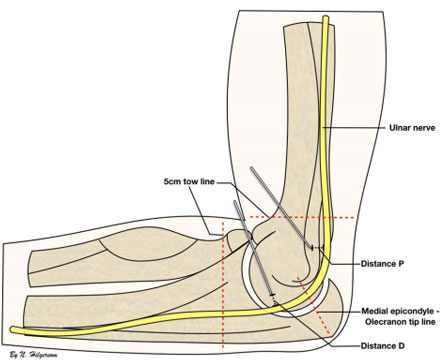Nick F. J. Hilgersom, Davide Cucchi, Francesco Luceri, Michel P. J. van den Bekerom, Luke S. Oh, Paolo Arrigoni, Denise Eygendaal1, ESSKA Elbow and Wrist Study Collaborative
Received: 11 June 2018 / Accepted: 13 August 2018
© The Author(s) 2018
Abstract
Purpose
Knowledge of ulnar nerve position is of utmost importance to avoid iatrogenic injury in elbow arthroscopy. The aim of this study was to determine how accurate surgeons are in locating the ulnar nerve after fluid extravasation has already occurred, and basing their localization solely on palpation of anatomical landmarks.
Methods
Seven cadaveric elbows were used and seven experienced surgeons in elbow arthroscopy participated. An arthroscopic setting was simulated and fluids were pumped into the joint from the posterior compartment for 15 min. For each cadaveric elbow, one surgeon was asked to locate the ulnar nerve solely by palpation of the anatomical landmarks, and subsequently pin the ulnar nerve at two positions: within 5 cm proximal and another within 5 cm distal of a line connecting the medial epicondyle and the tip of the olecranon. Subsequently, the elbows were dissected using a standard medial elbow approach and the distances between the pins and ulnar nerve were measured.
Results
The median distance between the ulnar nerve and the proximal pins was 0 mm (range 0–0 mm), and between the ulnar nerve and the distal pins was 2 mm (range 0–10 mm), showing a statistically significant difference (p = 0.009). All seven proximally placed pins (100%) transfixed the ulnar nerve versus two out of seven distally placed pins (29%) (p = 0.021).
Conclusions
In a setting simulating an already initiated arthroscopic procedure, the sole palpation of the anatomical landmarks allows experienced elbow surgeons to accurately locate the ulnar nerve only in its course proximal to the medial epicondyle (7/7, 100%), whereas a significantly reduced accuracy is documented when the same surgeons attempt to locate the nerve distal to the medial epicondyle (2/7, 29%; p = 0.021). Current findings support the establishment of a proximal anteromedial portal over a distal anteromedial portal to access the anterior compartment after tissue extravasation has occurred with regard to ulnar nerve safety.
Keywords: Elbow, Ulnar nerve, Arthroscopy, Physical examination, Nerve injury, Complication, Prevention

